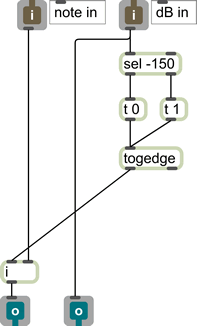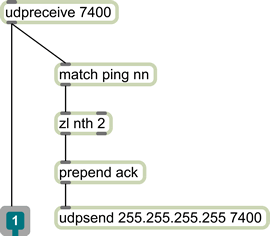The Regina Electroacoustic Performance Orchestra
Heterogeneity and Participation
During the 2008–09 academic year, I launched and directed a laptop orchestra at the University of Regina, in Saskatchewan, Canada. The group, known as the Regina Electroacoustic Performance Orchestra or “REAPOR,” performed with as many as eight laptops at a time, and was frequently joined by guest performers on various other instruments, be they “traditional” or electronic. The following is both a report on my experiences with this laptop orchestra, and an outline of areas for future exploration.
The decision to launch the orchestra had been inspired by the specific and highly visible model of the Princeton Laptop Orchestra, or “PLOrk.” Scaling creative research into instrument-like spherical speakers, human-computer interface design and computer music programming over a larger ensemble, the classical PLOrk configuration consists of 15 performers armed with a “meta-instrument” — an Apple Macintosh laptop, an audio interface, and a hemispherical speaker with six individually addressable speakers (Trueman et al 2006). A list of compositions created specifically for PLOrk can be found in Smallwood et al 2008, while interesting details of pedagogical methods and experiences with PLOrk are published in Wang et al 2008.
The laptop orchestra concept pioneered by PLOrk is interesting for all sorts of reasons. The laptop orchestra allows the spatiality of sound — a fundamental concern of various electronic music traditions since the breakthroughs of the 1940s and 1950s — to find a precise visual correlate in the corporeal presence, position and movements of those performers. At the same time, members of the orchestra have the chance to form an intimate, personal relationship with “their” instrument, which produces sound in very close proximity to their ears — rather than from far-flung points in a hall.
From the outset, the Regina Electroacoustic Performance Orchestra departed from the PLOrk model in a significant way: we used heterogeneous audio and computer equipment brought forth by the members of the orchestra itself. Rather than a standardized meta-instrument, we worked with various netbooks, Windows laptops and Macintosh laptops, and with audio interfaces ranging from the absolute worst built-in motherboard audio circuits to higher-end Firewire devices. Sometimes the differences between devices became a source of genuine interest — different computer keyboards seem to respond with different latencies and handle held and repeated keys differently, and the differences from one network interface to another can also be audible in performance.
Rehearsals of the orchestra emphasized a discipline of sound-based structured improvisation drawn from an encounter with Alain Savouret at the stage de création sonore of the Orford Arts Academy. A simple exercise consisted of seating the orchestra in a circle, loading a patch that could produce a single continuous synthesized pitch (or a restricted set of pitches) at volume levels controlled by each player, and then passing the pitch around the circle in overlapped “hairpins” (i.e. a crescendo from niente to some volume, followed by a corresponding decrescendo to niente), from one player to the next. Different spaces, different seating arrangements, and the occasional presence of new orchestra members, would change the “feel” of the exercise drastically. We carried this hairpin technique into more structured situations: at a given moment in a composition, for instance, the group could express a harmony by performing the overlapped hairpins on random distributions of pitches from the harmony, at some approximate “rate of transfer” determined experimentally and learned/taught as an oral tradition.
Both in response to this structured improvisation practice and as a spontaneous effect of the participation of a blind student in the orchestra, the orchestra rarely, if ever, employed visual cues during performance. We never once employed a traditional conductor with a baton, or other visual coordination devices such as cue cards/posters. In compositions with sequences of defined textures, the progress from one texture to the next was accomplished by networked coordination between the laptops in the ensemble, with a master laptop responsible for bringing the whole ensemble into the next cue.
Given the overlapped hairpin technique, a frequent compositional nuance was for pitches and other parameters that are active (i.e. not silent) at the moment of transition to hold over into the next cue or cues, until such time as the individual player silenced their output and began a new note. This is shown in the Max/MSP abstraction in Figure 1. Note messages (typically MIDI pitch messages) are received in the left inlet, but only go out the left outlet when the stream of level messages (in decibels) makes a transition from -150 dB (defined as silence) to some higher level.

Collaboration with non-laptop performers was an important part of the orchestra’s activities, and allowed us to engage with traditional music-making in a straightforward but experimental way. For instance, the orchestra performed Christmas carols with solo clarinet and solo jazz saxophone. The basic relationship of the “traditional” soloists to the orchestra was one of melody versus harmonic accompaniment, but we made use of the particular resources of the laptop orchestra in the form of a network-distributed vocoder. A master laptop decomposed the spectrum of the live soloist and then transmitted this data as UDP packets over the network. All of the other laptops produced synthetic pitches, rich in overtones, whose spectrum was then modulated by the UDP-transmitted vocoder analysis data. A similar technique was employed in my own composition Hexachord, for the laptop orchestra and a theremin: in that case, the theremin’s pitch was tracked by the Max/MSP external fiddle~ and distributed at different rates to the laptops in the orchestra.
Ensuring that all of the heterogenous laptops in the ensemble were able to receive and transmit network data was consistently difficult as we moved from space to space, configuration to configuration, and piece to piece. In order to cut down on the time involved in recognizing and solving network communication issues, a simple expedient was built into pieces involving network communication. The master laptop transmits messages of the form “ping 1” (to laptop 1) “ping 2” (to laptop 2) etc. Any laptop receiving a ping would respond with a broadcast UDP packet of the form “ack 1”, “ack 2” etc. If the master laptop received “ack 1” it would know that 2-way transmission with laptop 1 was possible — and the ongoing results of these tests (every few seconds) were displayed in a window. The Max/MSP excerpt in Figure 2 shows how this simple mechanism was built into every patch used by the orchestra as the standardized sub-patcher “NetReceive”.

In general, the orchestra “compensated” for the extreme diversity of computers, audio interfaces and network interfaces by adopting highly standardized Max/MSP patches for performance. Every patch included a standardized output abstraction (included via bpatcher) which allowed each performer to select their output audio device and attenuate their output levels by some number of decibels. The attenuation could be controlled both by touch alone (with standardized keyboard assignments) and by clicking and dragging a GUI element.
The thing I found most interesting about the Regina laptop orchestra was they way that it facilitated wider participation in electronic music culture. Members of the orchestra came from a range of different backgrounds, with and without music performance experience. In addition to performing with sound in the immediate context of the laptop orchestra, they participated in concerts and workshops of acousmonium-style diffusion presented by the newly-formed holophon.ca audio arts group (including a mass volunteer diffusion of the 60 one-minute compositions from the Canadian mix of the 60x60 project). In other words, the sound community that grew up around the laptop orchestra reinforced other emergent electroacoustic activities.
Henry Jenkins puts forward a concept of participatory cultures, which have:
relatively low barriers to artistic expression and civic engagement, strong support for creating and sharing one’s creations, and some type of informal mentorship whereby what is known by the most experienced is passed along to novices. (Jenkins et al 2006)
The Regina Electroacoustic Performance Orchestra met all of these criteria, and this suggests that the full context for research and advancement of the laptop orchestra phenomenon may be found not only within the established traditions of electronic music making but also in a wider consideration of community participation in the arts and ideas.
Acknowledgements
Special thanks to the following people who either provided crucial support or participated directly in the activities described above!: Lynn Cavanagh, Charlie Fox, Erin Gee, David Gerhard, Paul Gingrich, John Hampton, Kyle Ivey, Charity Marsh, Pauline Minevich, Devin Oxman, Alain Perron, Kevin Petrychyn, Carter Powley, Randal Rogers, Christina Marie Willatt, Andrew Wenaus, and Ila Wenaus.
Bibliography
Jenkins, Henry, Katie Clinton, Ravi Purushotma, Alice J. Robinson and Margaret Weigel. “Confronting the Challenges of Participatory Culture: Media Education for the 21st Century.” The John D. and Catherine T. MacArthur Foundation, 2006, pp. 1–68.
Smallwood, Scott, Dan Trueman, Perry Cook and Ge Wang. “Composing for Laptop Orchestra.” Computer Music Journal 32/1 (Spring 2008), pp. 9–25.
Trueman, Daniel, Perry Cook, Scott Smallwood and Ge Wang. “PLOrk: The Princeton Laptop Orchestra, Year 1.” Proceedings of the International Computer Music Conference (ICMC) 2006 (New Orleans, USA: 2006).
Wang, Ge, Dan Trueman, Scott Smallwood and Perry Cook. “The Laptop Orchestra as Classroom.” Computer Music Journal 32/1 (Spring 2008), pp. 26-37.
Social top